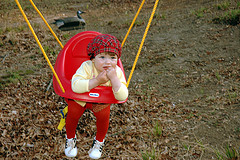The Girl of late has been doing a lot to shake up my notions of what it means to communicate and all the different ways it’s possible to share a thought with another person.

The biggest preconception she’s radically challenged is the age at which an individual can create novel ways of communicating. We’ve been using baby signing with L, and she’s picked up on several signs that she uses regularly now: eat, more, and bath are among them. She understands a lot more — sleep, drink, potty/diaper change — but that’s not terribly impressive in that she already understands a great deal of spoken language. What shocked me recently about the signing was that L created her own sign for a word that she understands: swing. She waves her right arm back and forth at about shoulder level when she wants to go swing — which is pretty much constantly.
Another preconception: the ability to speak develops much later in children raised in a multilingual environment than it does in a monolingual home. L has a few words that she uses to great effect.
- dac (“give”, pronounced “dach”)
- tam (“there”, pronounced more or less as it appears)
- down
She’s got a few more that she almost says, and at least one L-ism: “baaa” is bannana.
But her understanding of both Polish and English is amazing. We ask her many things in both Polish and English and she understands them both unhesitatingly.
All this culminates in the last unexpected change: an increase in crying. She knows what is possible with communication now — in a word, everything — but she lacks the skills to tell us everything she wants or needs. And the resulting frustration manifests itself in crying/screaming fits more often than we’d like.
The developments of the last few weeks, though, promise a quick end to these fits. In other words, the problem is the solution.